Is AI taking over jobs in 2024?
Get Started with HubSpot's AI Campaign Assistant
A quarter of workers are worried it is.
There’s even a website called “Will Robots Take My Job?” where you can input a job title and see the likelihood of AI taking it over. I’ll admit that I’m even affected by this fear, checking the website more often than I’d like to admit.
The site is interesting to explore, but it’s important to understand the facts. So, I took a deep dive into the site to see what jobs have staying power and which don’t.
In this post, I’ll discuss the impact it’s already had, a list of jobs that AI can and cannot replace, and expert advice on how to future-proof your career and come out on top.
Table of Contents
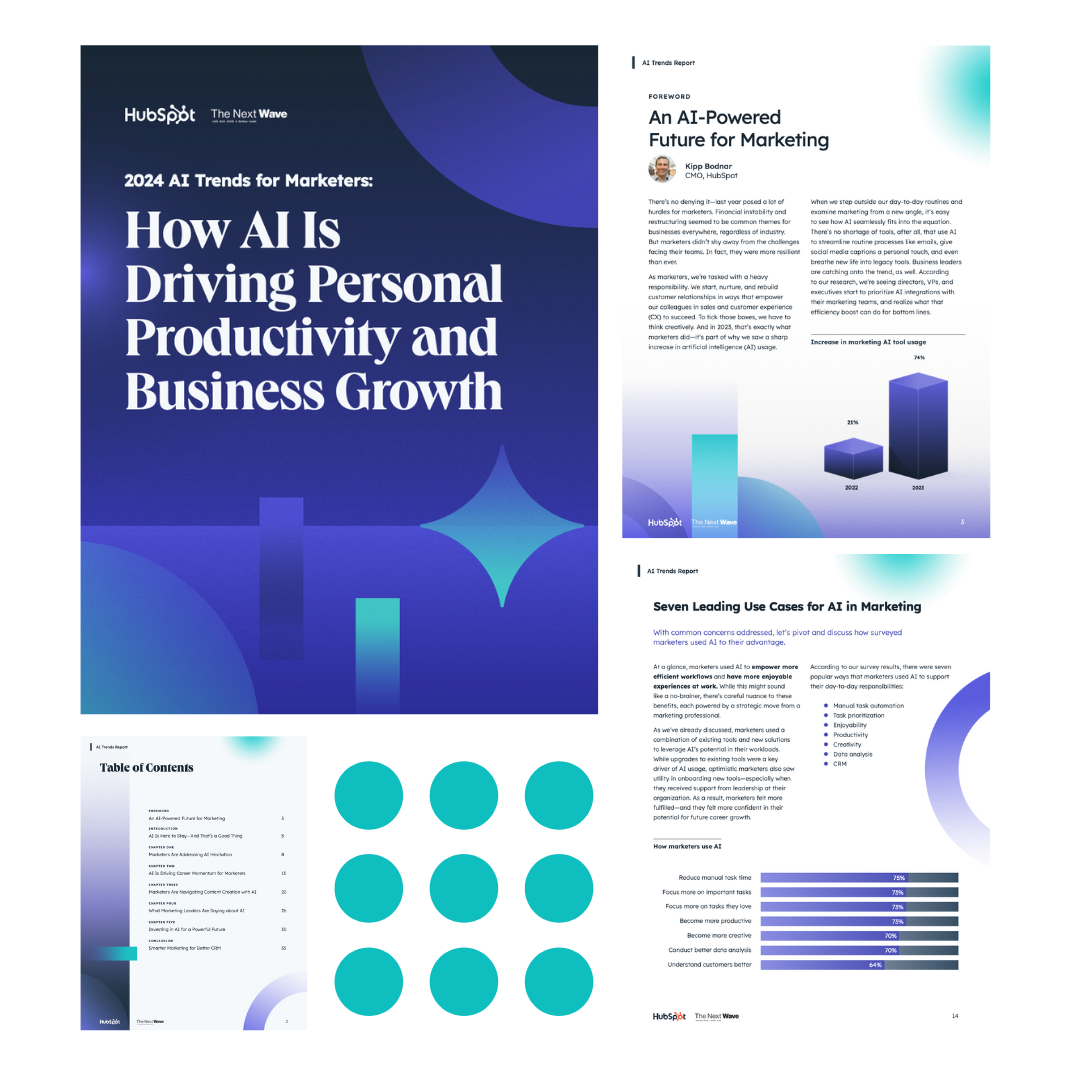
The State of Artificial Intelligence in 2024
New research into how marketers are using AI and key insights into the future of marketing.
- Marketing AI Tools
- Practical Tips
- Trends and Statistics
- And More!
Download Free
All fields are required.

Artificial intelligence disruption is already happening.
AI once posed the most significant disruption to assembly lines. The recent AI boom has changed that, as advancements have introduced AI to many different industries and businesses, and more and more workers leverage it to do their jobs.
For example, salespeople are using AI to analyze sales calls faster, bloggers and content creators are already using AI to streamline the writing process, and customer support reps are bringing customers faster solutions.
Salespeople are now using AI to analyze sales calls faster, marketers and digital creators are creating multi-channel content at greater speed, and customer support reps are bringing customers faster solutions.
Such functions lead to greater ROI for businesses, and this is shooting the AI optimism off the roof according to our 2023 State of AI report.
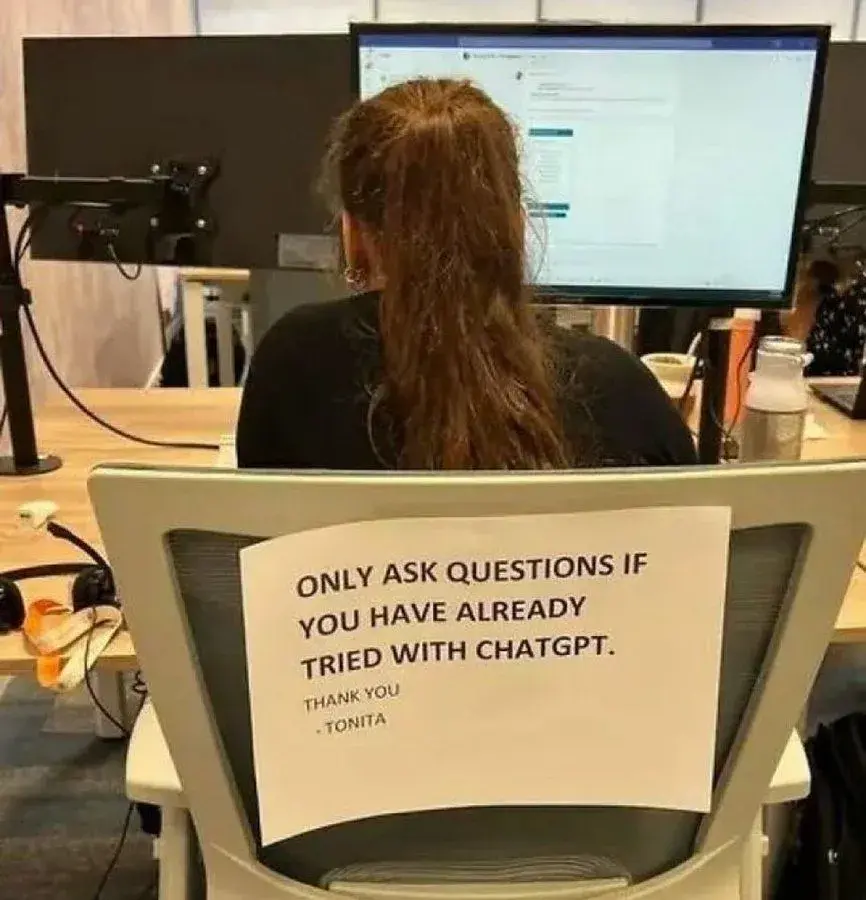
However, as advancements continue, will the disruption become so great that the workforce will find themselves asking, will ChatGPT replace me?
HubSpot Co-Founder and CTO Dharmesh Shah has a positive outlook on the future of AI. In fact, he thinks bots and AI will make us better at our jobs and more secure in our careers, not the other way around.
Samyutha Reddy, Jasper’s head of enterprise marketing, thinks similarly. Her teams regularly use generative AI, but she’s still actively hiring because AI can’t replace the human experience.
“We value writers in our society because they‘re able to give us a thought-provoking human perspective on the world…it’s about humans sharing opinions on very real topics that help build your perspective on how you feel about something. So an AI could really never replace that human perspective,” she says.
Despite the expert opinions of Shah and Reddy, you might still be anxious about where your career stands. I sometimes find myself lying in bed, scrolling through Reddit threads about the robot uprising. So, I put my mind at ease by turning to data.
Based on current data and the website Will Robots Take My Job?, I’ll explore what jobs AI can replace highlighting ten positions with a higher likelihood. I’ll also explore which jobs are safe from AI, highlighting ten job roles least likely to be replaced by this technology.
What jobs can AI replace?
Once in the past, concerns over machines replacing human jobs rose with the automation of physical tasks common in factories and warehouses. Now, the same is happening with AI and the fear of it replacing human intelligence in the workplace.
“Think about your position and what your position will transform to in the next 12 to 24 months. Whether you like it or not, this is happening, and it is going to happen so fast that it will change the fabric of our society. If you haven't already done so, search for whatever your title or your position is and look at all the [AI] tools that exist within that,” Duran Inci, CEO at Optimum7 says.
Before ChatGPT exploded in 2022 and unleashed the capabilities of AI to the average user, AI had already been making inroads in the sector. Business leaders were already hiring AI specialists, devising ways to use the technology to 10x their productivity, according to a report by PwC.
Between 2012 and 2023, jobs with AI-specific skill requirements increased sevenfold. In contrast, regular jobs only doubled within the same timeframe. But while the demand for professionals with technical AI skills may be on the rise, traditional jobs with high exposure to AI may be left on the back burner.
And from a Pew Research Center study, one in five Americans work a job with “high exposure” to (this exposure is measured by how much of the job’s most important activities can be performed or supported by AI).
Job roles that involve work activities like “getting information, processing information, analyzing data and information, thinking creatively, evaluating information to determine compliance with standards, making decisions or solving problems, performing for or working directly with the public, and more” fall under that category.
And these are the jobs that AI can replace. Not entirely, but to a significant extent affecting 30% of current worked hours by 2030.
“I would say 40% to 50% of creative and generic positions are already 80% there, and you will lose millions of dollars in the next 10 to 20 years if you don’t already have the plus version of ChatGPT and if you don't already use it,” Inci continues.
What this means is that the greater the level of AI exposure a job has, the greater the risk of replacement.
Here are some examples.

The State of Artificial Intelligence in 2024
New research into how marketers are using AI and key insights into the future of marketing.
- Marketing AI Tools
- Practical Tips
- Trends and Statistics
- And More!
Download Free
All fields are required.

10
- Telemarketing
- Bookkeeping Clerks
- Compensation and Benefits Managers
- Receptionists
- Couriers
- Proofreaders
- Computer Support Specialists
- Market Research Analysts
- Advertising Salespeople
- Retail Salespeople
1. Telemarketers
Future of Employment Study Likelihood: 99%
Will Robots Take My Job? Likelihood: 100%
Why: You probably already receive robocalls on behalf of various products and services, and career growth in the telemarketing space is expected to decline by 18.2% by the year 2032. This is largely because of the requirements to be successful. Unlike other roles, these jobs often require repetitive and predictable tasks that can easily be automated.
However, successful human telemarketers have a level of social perceptiveness and emotional awareness that machines can never replicate.
2. Bookkeeping Clerks
Future of Employment Study Likelihood: 99%
Will Robots Take My Job? Likelihood: 100%
Why: Jobs in this role are expected to decline 4.5% by 2032, and it‘s no surprise why — most bookkeeping is becoming automated if it hasn’t been already. QuickBooks, FreshBooks, and Microsoft Office already offer software that does the bookkeeping for you, so it's no surprise this job has such a high probability.
3. Compensation and Benefits Managers
Future of Employment Study Likelihood: 96%
Will Robots Take My Job? Likelihood: 41%
Why: As companies grow, especially across multinational markets, a human and paper-based system can present more hurdles, time delays, and costs. That’s why there is a 64% chance of full automation within the next two decades.
Automated benefits systems can save time and effort by providing benefits to large numbers of employees, and companies like Ultipro and Workday are already being widely adopted.
4. Receptionists
Future of Employment Study Likelihood: 96%%
Will Robots Take My Job? Likelihood: 93%
Why: Pam predicted this back on The Office, but in case you‘re not a fan, she said automated phone and scheduling systems can replace a lot of the traditional receptionist role — especially at modern technology companies that don’t have office-wide phone systems or multinational corporations.
But, receptionists develop relationships in the office that give them a unique advantage in providing customized support compared to an algorithmic system.
5. Couriers
Future of Employment Study Likelihood: 94%
Will Robots Take My Job? Likelihood: 95%
Why: Couriers and delivery people are already being replaced by drones and robots, so it’s only a matter of time until this space is dominated by automation altogether.
6. Proofreaders
Future of Employment Study Likelihood: 84%
Will Robots Take My Job? Likelihood: 100%
Why: Only a few jobs have a 100% risk level and this is unfortunately one of them. Proofreading software is everywhere. From Microsoft Word’s simple spelling and grammar check to Grammarly and Hemingway App, there are a lot of technologies out there that make it easy to self-check your writing.
On the other hand, the relationship a proofreader develops with a client gives them an understanding of the intention behind a writer's work and the contextual knowledge needed to successfully complete a project.
7. Computer Support Specialists
Future of Employment Study Likelihood: 65%
Will Robots Take My Job? Likelihood: 52%
Why: The field is projected to grow by 6.2% by 2032. But with so much content on the internet with instructions, step-by-step guides, and hacks out there, it’s no surprise companies will rely more heavily on bots and automation to answer support questions from employees and customers in the future.
8. Market Research Analysts
Future of Employment Study Likelihood: 61%
Will Robots Take My Job? Likelihood: 40%
Why: Market research analysts play an incredibly important role in developing messaging, content, and products, but automated AI and surveys can compile this information more and more efficiently.
While automated research tools can have a leg up in scale, speed, and accuracy, a human researcher has hands-on knowledge and personal experience that an algorithm can’t develop. Human researchers that leverage automation tools can create a more effective process.
9. Advertising Salespeople
Future of Employment Study Likelihood: 54%
Will Robots Take My Job? Likelihood: 52%
Why: As advertising shifts away from print and TV and towards web and social media landscapes, people simply aren't needed to manage those sales for marketers who want to buy ad space.
Social media platforms make it easy for people to buy space through free application program interfaces (APIs) and self-serve ad marketplace, removing the salesperson and making it faster and easier for users to run their ads.
Even the ads themselves are leaning more and more in artificial intelligence. When looking at actors or voice actors, we're also seeing a trend of companies using AI voices for advertisements like commercials.
10. Retail Salespeople
Future of Employment Study Likelihood: 92%
Will Robots Take My Job? Likelihood: 66%
Why: Companies are democratizing the shopping experience with features like self-checkout, and the modern buyer is much more internet-savvy and more likely to do internet research and make a buying decision on their own.
On the other hand, the care a retail salesperson brings during a 1:1 interaction differs from automated and unemotional support, and many consumers prefer to interact with humans during the support process.
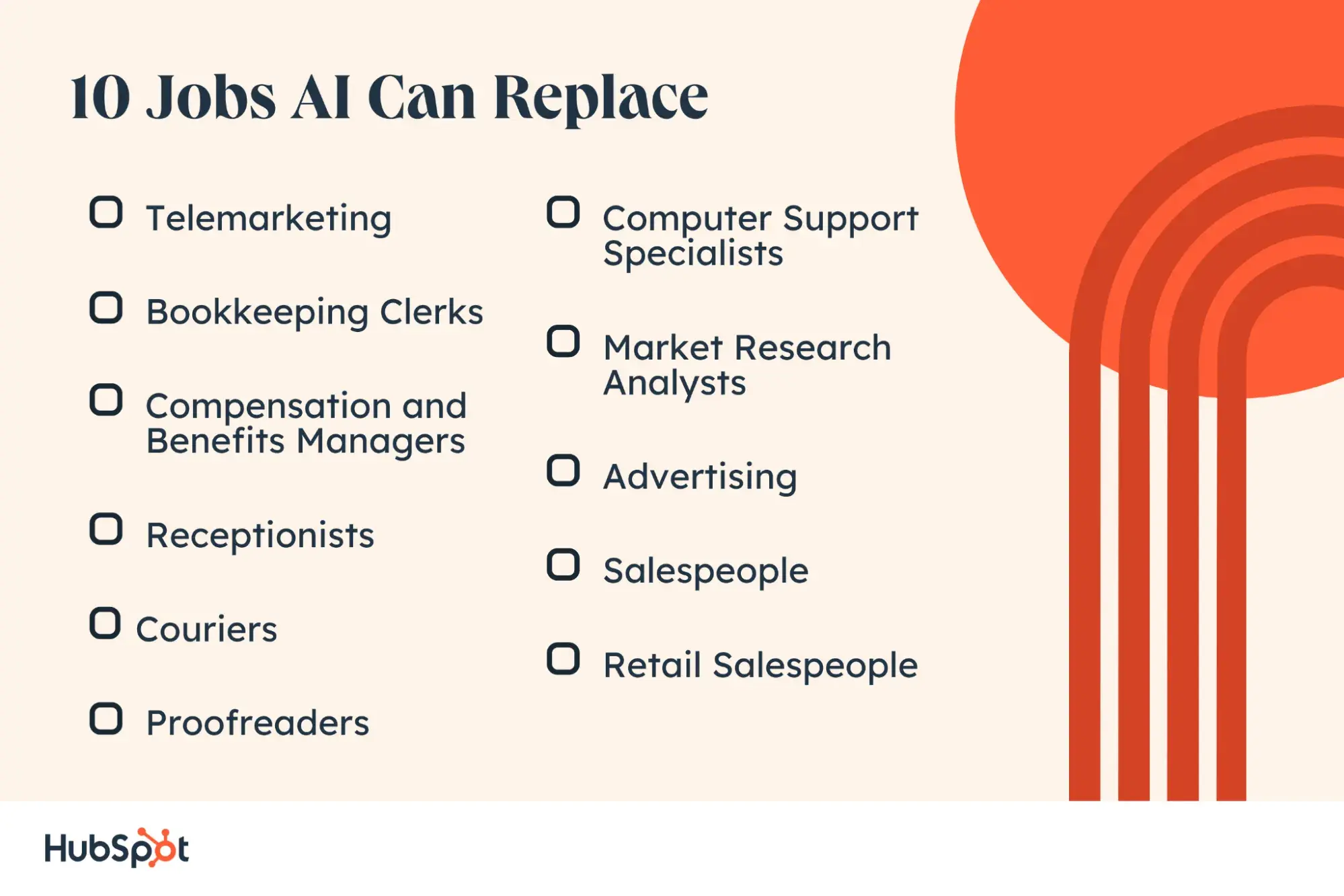
What jobs are safe from AI?
Although data suggests generative AI could expose over 300 million full-time jobs across the US and Europe to automation, certain roles remain largely immune to this. Going by the exposure scale, these jobs have medium to low exposure to AI.
This is because their most important work activities range from:
- Training and teaching others
- Performing general physical activities
- Repairing and maintaining equipment
- Establishing and maintaining interpersonal relationships
- Resolving conflicts and negotiating with others
- Developing and building teams
- Selling or influencing others
- Judging the qualities of objects, services, or people
What these activities revolve around are uniquely human traits like emotional intelligence, contextual creativity, discernment and manual labor that AI cannot replicate yet. This is also echoed by the World Economic Forum’s (WEF) top 10 work skills of 2025, some of which include:
- Analytical thinking and innovation.
- Critical thinking and analysis.
- Creativity, originality, and initiative.
- Leadership and social influence.
- Complex problem-solving.
And this is true for business leaders and their hiring practices. At GuerrillaBuzz, Co-Founder Yuval Halevi, says they rely mainly on human creativity to drive their marketing efforts. “We apply AI mainly to repetitive and time-consuming tasks, removing the monotony and freeing up time for more creative work.”
In the words of Ian Shine at the WEF, these jobs are safe because “one of the human brain’s biggest advantages over AI is the fact that it is attached to a real human body.”
Without further ado, here are some jobs that are safe from AI.

The State of Artificial Intelligence in 2024
New research into how marketers are using AI and key insights into the future of marketing.
- Marketing AI Tools
- Practical Tips
- Trends and Statistics
- And More!
Download Free
All fields are required.

10
- Human Resource Managers
- Sales Managers
- Marketing Managers
- Public Relations Managers
- Chief Executives
- Event Planners
- Writers
- Software Developers
- Editors
- Graphic Designers
1. Human Resources Managers
Future of Employment Study Likelihood: 0.55%
Will Robots Take My Job? Likelihood: 14%
Why not: It’s kind of in the name — but your company’s Human Resources department will likely always need a human at the helm to manage interpersonal conflict with the help of non-cognitive and reasoning skills. Problem solving, contextual understanding, and unique business knowledge also make a human better equipped for this job.
The field is projected to grow 7.3% by 2032 as companies scale and need more robust structures for supporting and helping employees.
2. Sales Managers
Future of Employment Study Likelihood: 1.3%
Will Robots Take My Job? Likelihood: 30%
Why not: Sales managers need high emotional intelligence to hit their monthly quotas, network and collaborate with customers, and motivate and encourage the larger sales team. Managers also have to analyze data and interpret trends. The high levels of intelligence required and the constant need to adapt to new situations make this role safe from automation.
3. Marketing Managers
Future of Employment Study Likelihood: 1.4%
Will Robots Take My Job? Likelihood: 18%
Why not: Marketing managers have to interpret data, monitor trends, oversee campaigns, and create content. They also have to nimbly adapt and respond to changes and feedback from the rest of the company and customers, making this another human-forward career AI isn't quite ready to replicate.
A unique contextual understanding and previous business experience make a human stand out from an automated system.
4. Public Relations Managers
Future of Employment Study Likelihood: 3.7%
Will Robots Take My Job? Likelihood: 8%
Why not: Successful public relations (PR) managers rely on a network of relationships and contacts to procure press placements and buzz for the companies they represent, making this another completely safe role.
PR managers who have to raise awareness around an issue or mission need a particularly human touch to raise funds or get people to participate in a campaign, too — and jobs are expected to grow 7.6% by 2032.
Most importantly, PR managers are often on the go, attending events and being on hand to provide support if need be — a computer will never be able to do this.
5. Chief Executives
Future of Employment Study Likelihood: 1.5%
Will Robots Take My Job? Likelihood: 0%
Why not: It‘s nearly impossible to automate leadership — after all, it’s hard enough to teach it. Chief executives must inform broad strategy, represent companies' missions and objectives, and motivate huge teams of people working for them. Executives also have years of prior experience that make them successful.
Companies may answer to stakeholders and boards of directors, who likely wouldn't want a robot giving them an earnings report, either.
6. Event Planners
Future of Employment Study Likelihood: 3.7%
Will Robots Take My Job? Likelihood: 8%
Why not: Event planning is a growing field, and if you ask anyone on our events team here at HubSpot, whether you're planning an event for employees, customers, or an industry event with tens of thousands of attendees, the planning process has many, many moving parts involved.
Planners have to coordinate and negotiate with vendors, contractors, and freelancers to make things come together, and the organizational and people skills involved will make this another near-impossible role to automate.
Planners also attend events, ready to step in and troubleshoot on the spot. An automated tool simply couldn’t be present.
7. Writers
Future of Employment Study Likelihood: 3.8%
Will Robots Take My Job? Likelihood: 49%
The large score difference is likely due to developments and advancements in language models post-2013 that can write entire blog posts or social media content.
Why not: Writers have to ideate, create, and produce original written material, something that AI writing tools have not yet been able to replicate in the same way as humans (see recent BuzzFeed controversy about AI-generated travel articles).
There are also many types of writers, some of which might be more at risk. An experienced journalist will likely be favored over AI, but a freelance copywriter may no longer be needed by a business that now uses AI to write Instagram captions.
8. Software Developers
Future of Employment Study Likelihood: 4.2%
Will Robots Take My Job? Likelihood: 39%
The large score difference is likely because of new back-end tools that help web developers write entirely new code, fill in gaps, and debug.
Why not: Software engineering and development is complex enough for human beings, and the time and skill investment needed to create applications, software, and websites will be tough to replicate — especially since developers need to execute perfectly to create great products for customers.
The field is expected to grow by 30.3% by 2032, so if you‘re a software developer, you’re sitting pretty for now.
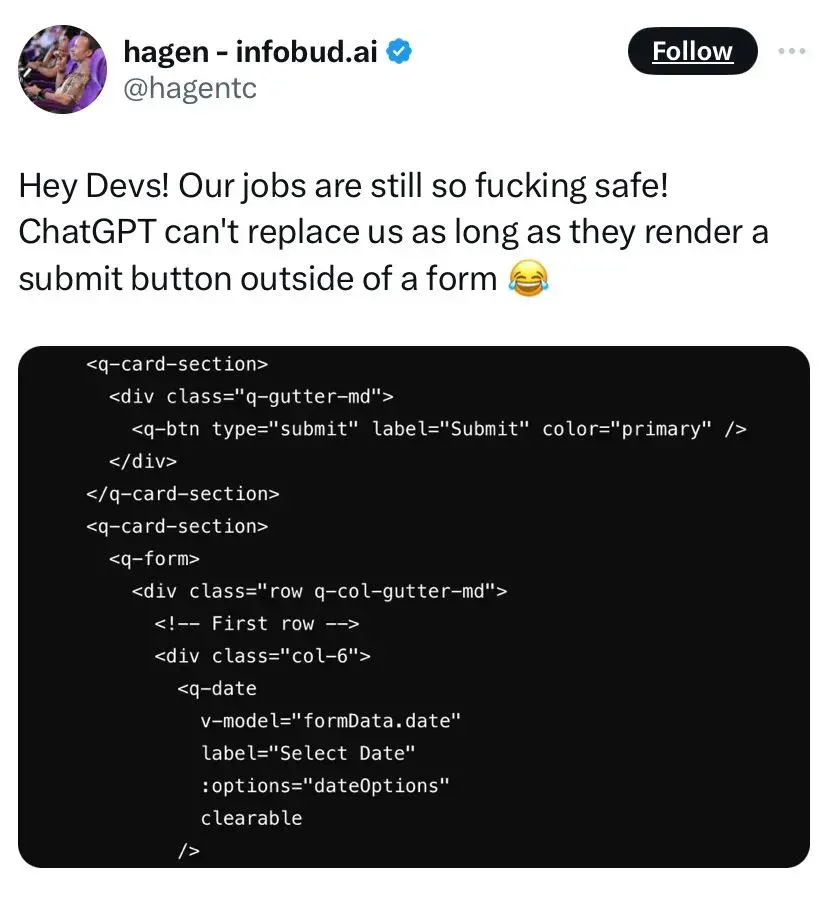
9. Editors
Future of Employment Study Likelihood: 5.5%
Will Robots Take My Job? Likelihood: 45%
Why not: While the automated proofreading technology mentioned previously can take a load off, editors have to review writers' submission for clarity, accuracy, comprehensiveness, and originality.
Some software can spot-check for clarity and scan for plagiarism, but the editor role must be carried out by a human in order to read work as another human would.
Today, 86.33% of marketers who use AI, for example, always make edits to the content that AI produces, according to our State of AI in Marketing survey.
10. Graphic Designers
Future of Employment Study Likelihood: 8.2%
Will Robots Take My Job? Likelihood: 34%
Why not: Image generators like Midjourney and DALL-E make it easy for people to create what they want, but graphic design is an artistic and technical field best suited for someone with fine arts training and experience. Like writing, graphic design work must be original and tailored to a unique use case.
If a graphic designer is working with a business, it also requires building a relationship between both parties throughout the design process. Plus, some image creators have been found to plagiarize artists' work — a lawsuit is likely the last thing people want.
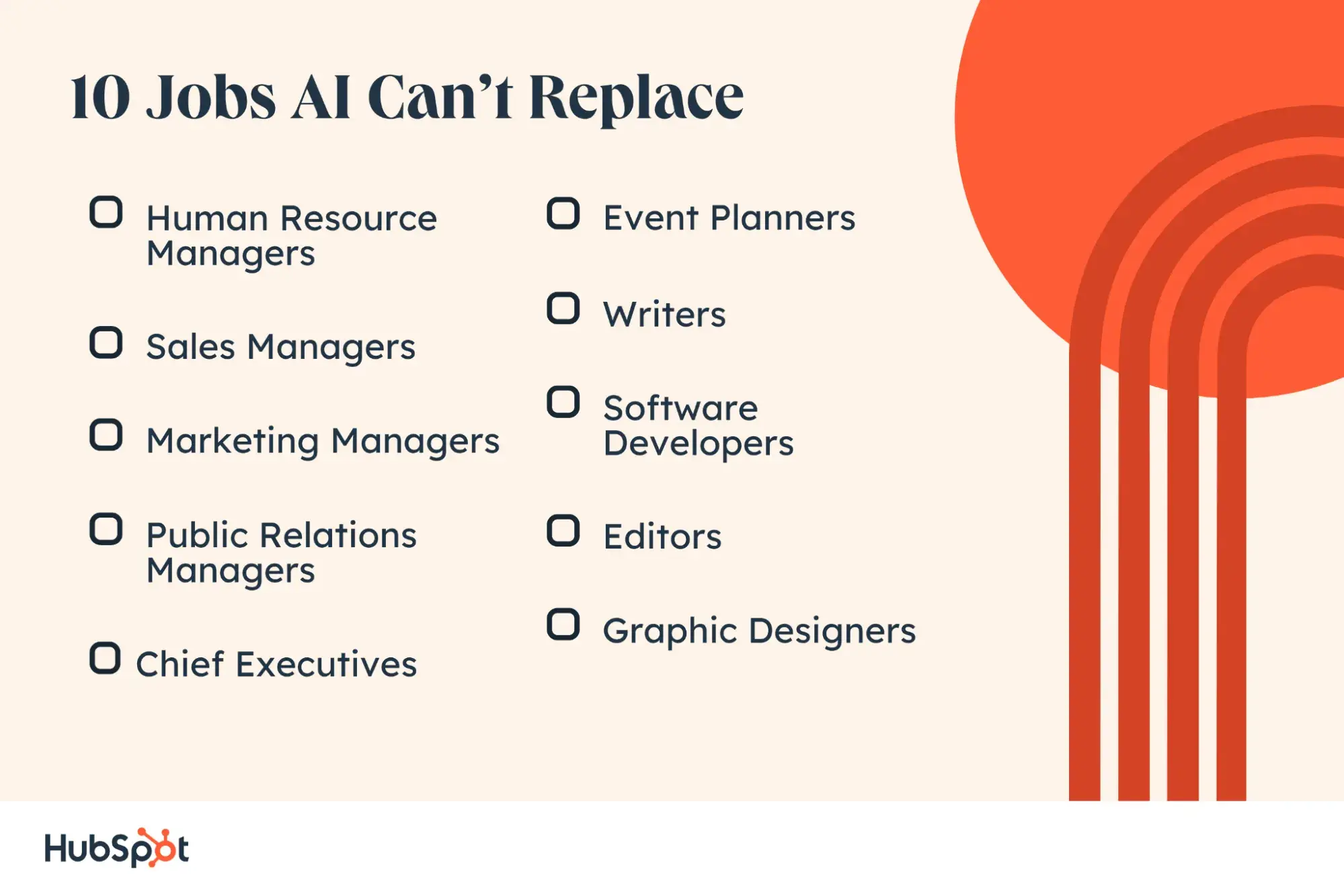
Navigating Artificial Intelligence
Kate O'Neill, the author of Tech Humanist and founder of KO Insights, explains that jobs that require emotional intelligence will be safer in the immediate future:
“This is going to be a continuously moving target, but for the time being, what AI can't do well is use emotional intelligence, understand situational context, make judgment calls, and generally see nuance and meaning like we do.”
“That means any kind of job that benefits from these kinds of human attributes is better off done by a human. A computer or robot may assist you in performing efficiently, but for now, you're the one who adds the expertise on how to perform appropriately,” she adds.
This is echoed by Halevi, who says, "Having knowledge that's beyond the obvious is crucial. AI tools like ChatGPT and Gemini can sometimes provide inaccurate or misleading information."
"Without a deep understanding of your specific area, you might be misled or produce subpar work. Expertise ensures you can critically evaluate AI outputs and maintain high-quality standards."
Even for jobs that are more likely to be impacted, there are always reasons why a human with real-life experience and expertise is a better fit. The best way to navigate the fast-moving world of artificial intelligence is to stay informed and adaptable.
How to Future-Proof Your Career
Between January and May 2023, 417,500 jobs were cut. However, only 3,900 were reportedly because of artificial intelligence — less than 1%. Still, regardless of what happens, you might be wondering how to future-proof your career. The answer? Re-skilling.
On a Marketing Against The Grain Episode, Kipp Bondar, HubSpot’s chief marketing officer, says, “As I think about the evolution of AI, I think about one of the things that’s going to go part and parcel with it is the need to be amazing at re-skilling our workforce all around the world.” (Listen to the full episode here).
Re-skilling doesn’t mean preparing for the worst. Most jobs expect employees to engage in some sort of professional development, so this might be routine for you.
For example, you could explore different AI tools and how to leverage them in your day-to-day role. HubSpot’s AI tools, for instance, give you access to a suite of AI tools that could perform functions like content creation, data analysis, and even build a chatbot.
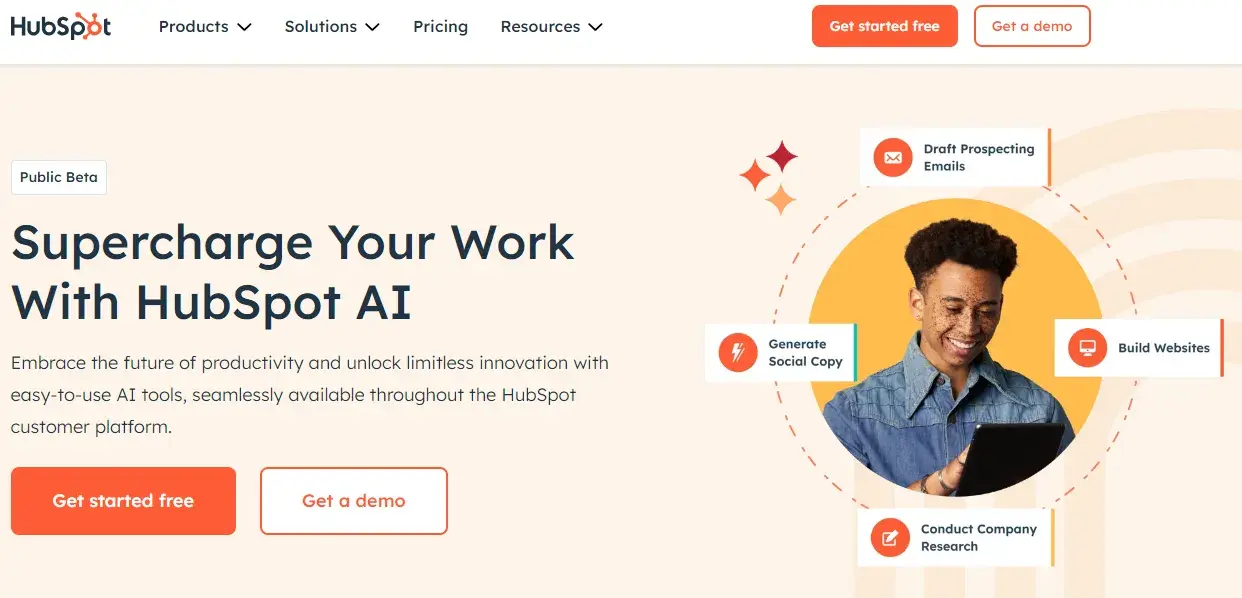
Or you could take a course to learn a new skill. As Shah said above, AI’s most significant impact will likely be helping us be more effective in our careers.
But, if your job is impacted, having taken the time to re-skill leaves you more prepared for future opportunities where you present yourself as a multifaceted candidate.
Learning from others is another great way to stay on top of the changing AI landscape and learn new skills. HubSpot has spoken to experts that have leaned into AI and incorporated it into their processes, and their insight is a valuable way to get ideas for re-skilling.
Here are some helpful resources:
- Use A.I. To Accelerate Your Career While Others Panic (Complete Guide) (Podcast)
- How AI Will Change Podcast and Video, According to Riverside's Head of Marketing
- 7 Creative Ways Sales Reps Are Using AI
- Here‘s How HubSpot’s Web Strategy Team is Using AI
- How to Fit AI Into Your Content Marketing Strategy [+ Its Biggest Pitfalls], According to Jasper's Head of Enterprise Marketing
Your experience is your greatest asset.
All technological revolutions impact how people work, and AI will simply follow this pattern, having the most impact on rote and mundane tasks to save us time.
No matter what happens, your experience is your greatest asset in the face of a changing landscape. To stay up to date on AI and the trends, HubSpot’s State of AI pillar houses all the information you need.

The State of Artificial Intelligence in 2024
New research into how marketers are using AI and key insights into the future of marketing.
- Marketing AI Tools
- Practical Tips
- Trends and Statistics
- And More!
Download Free
All fields are required.


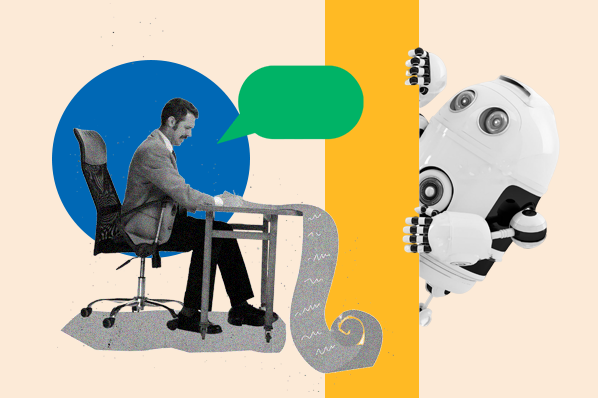


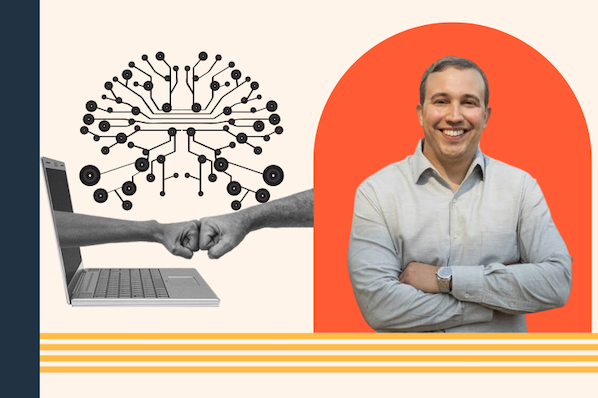

![Which LLM Should You Use for Your Business? [Pros and Cons]](https://www.hubspot.com/hubfs/which%20llm%20to%20use.png)

![Is it Real or AI? Test Your Detection Skills [Round 4]](https://www.hubspot.com/hubfs/real%20or%20ai%204.png)
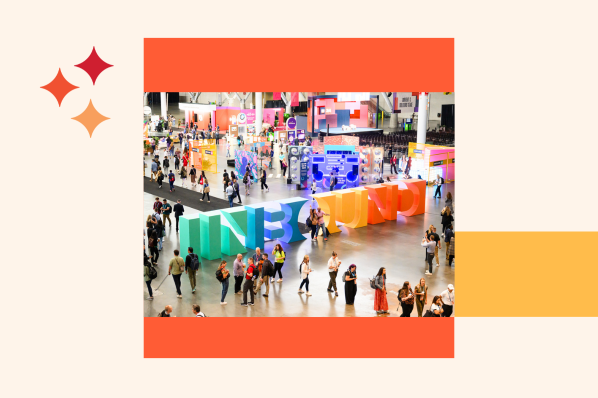

![Which AI Tool Writes the Best Marketing Copy? [I Tested Several Different Tools]](https://www.hubspot.com/hubfs/Untitled%20design%20%2842%29-1.jpg)